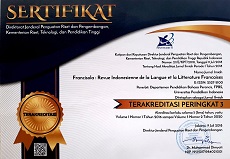Stéréotypes et double fardeau de femme dans La Femme Gelée d’Annie Ernaux
Abstract
RÉSUMÉ. Dans de nombreuses situations, les femmes subissent des stéréotypes et un double fardeau, car les rôles reproductifs des femmes sont considérés comme statiques et permanents. L'augmentation du nombre de femmes travaillant dans la sphère publique ne réduit pas leur charge de travail dans la sphère domestique. Cet article a pour but de démontrer les stéréotypes et double fardeau auprès de femme dans le roman La Femme Gelée écrit par Annie Ernaux. La recherche est menée en utilisant la méthode descriptive-qualitative. Les données, sous forme de mots, phrases, et paragraphes, sont prises du roman étant objet d’analyse, en utilisant la technique de documentation. Elles sont alors classifiées, identifiées, et étudiées en employant l’approche du critique féministe en basant sur les théories entre autres venant de Beauvoir, Butler, Humm, et Friedan. Le résultat du travail montre que les stéréotypes et le double fardeau subis par les femmes sont une forme d'injustice due aux inégalités de genre. Malgré l'idée accentuée que la femme a aussi le droit de s’exprimer et de bâtir sa carrière, l’analyse montre que la structure patriarcale positionne déjà les femmes marginalement ce qui rend difficile l’effort de le changer.
Mots-clés : stéréotype, double fardeau, femme, critique féministe, annie ernaux
ABSTRACT. In many situations, it is women who are instead given stereotypes and a double burden, as women's reproductive roles are seen as static and permanent. The increase in the number of women working in the public sphere does not reduce their workload in the domestic sphere. This article aims to demonstrate the phenomena of stereotypes and double burdens with women in the novel La Femme Gelée written by Annie Ernaux. The research is carried out using the descriptive-qualitative method. In the form of words, sentences, and paragraphs, the data is taken from the novel analyzed using documentation. The data is then classified, identified, and studied using the feminist critic's approach by practicing theories from Beauvoir, Butler, Humm, and Friedan. The result shows that stereotypes and the double burden suffered by women are a form of injustice due to gender inequalities. Despite the idea that, like the man, the woman also has the right to express herself and build her career, the novel shows that the patriarchal structure already positions women marginally, making it difficult to change it.
Keywords : stereotype, dual burden, femme, feminist criticism, annie ernaux
Full Text:
PDFReferences
Ahmad, M. (2019). Pandangan Lima Tokoh Perempuan terhadap Pernikahan dalam Novel Menikah Karya Jane Maryam. Jentera, 8(2), p. 233-251.
Azzahra, J. (2021). Resistensi Tokoh Utama dalam Menghadapi Ketidakadilan Gender pada Novel “La Femme Gelée” Karya Annie Ernaux [Mémoire, Universitas Padjadjaran]. Bandung.
Beauvoir, S. d. (2010). The Second Sex. Random House, Inc.
Bliss, J. A. (2013). Writing as Flat as a Photograph: Subjectivity in Annie Ernaux's La Place. Lit: Literature Interpretation Theory, 24(2), p. 164-183. https://doi.org/http://www.tandfonline.com/action/showCitFormats?doi=10.1080/10436928.2013.785172
Bogdan, R., & Biklen, S. K. (1982). Qualitative research for education: An introduction to theory and methods. Allyn and Bacon.
Butler, J. (1990). Gender Trouble: Feminism, and the Subversion of Identity. Routledge.
Cahn, N. R. (1999). Gendered Identities: Women and Household Work. Vill. L. Rev, 44, p. 5-25.
Ernaux, A. (1981). La Femme Gelée. Gallimard.
Ernaux, A. (2009). Raison d’Ecrire. Nottingham French Studies, 48(2), p. 10-14.
Friedan, B., & Quindlen, A. (2001). The Feminine Mystique (reprint). W.W Norton and Company Ltd.
Havercroft, B. (2016). Ecriture et sépulture dans L’Autre Fille d’Annie Ernaux. French Forum, 41(1-2), p. 5-15.
Hugueny-Léger, E. (2007). Je e (s) t les autres; transgressions textuelles, déplacement littéraires et enjeux sociopolitiques du transpersonnel dans l’oeuvre d’Annie Ernaux [Dissertation, Durham University]. Durham.
Hugueny-Léger, E. (2012). En dehors de la fête: entre présence et absence, pour une approche dialogique de l’identité dans Les Années d’Annie Ernaux. French Studies, 66(3), p. 362-375. https://doi.org/10.1093/fs/kns080
Humm, M. (2007). Ensiklopedia Feminisme (M. Rahayu, Trans.). Fajar Pustaka Baru.
Intan, T., Nurul Hikmayaty Saefulah, Ferli Hasanah, Vincentia Tri Handayani. (2019). Le symbolisme dans la gastronomie française et indonésienne : Revue interculturelle. Francisola : Revue indonésienne de la langue et la littérature françaises, 4(2), p. 33-44. https://doi.org/10.17509/francisola.v4i2.24205
Jellenik, C. (2017). Annie Ernaux and L’autre fille : Writing Absence. Women in French Studies, 25, p. 160-171. https://doi.org/https://doi.org/10.1353/wfs.2017.0012
Jordan, S. (2011). Writing Age: Annie Ernaux’s Les Années. Forum for Modern Language Studies, 47(2), p. 138–149. https://doi.org/10.1093/fmls/cqq080
Jordan, S. (2013). Autofiction in the Feminine. French Studies, 67(1), p. 76-84. https://doi.org/https://doi.org/10.1093/fs/kns235
KPPPARI. (non daté). Beban Ganda. Retrieved from https://www.kemenpppa.go.id/index.php/page/view/23
Long, J. (1999). Teling’s Women's life. NYU Press.
Moleong, L. J. (2012). Metode Penelitian Kualitatif. Remaja Rosdakarya.
Oza, B. (2019). Self, Identity and Space in Annie Ernaux’s A Frozen Woman. Research Chronicler, International Multidisciplinary Refereed Peer Reviewed Indexed Research Journal, 7(11), p. 1-7. http://research-chronicler.com/reschro/pdf/v7i11/71101-Ms._Bijal_Oza.pdf
Petroski, D. J., & Edley, P. P. (2006). Stay-at-home fathers: Masculinity, family, work, and gender stereotypes. Electronic Journal of Communication, 16(3/4), p.
Priyatna, A. (2013). Negotiating and Rethinking Local Culture : The Narratives of Indonesian Women Juggling Higher Education, Work, and Domestic Roles. Asian Journal of Women's Studies, 19(4), p. 95-123.
Priyatna, A. (2018). Kajian Budaya Feminis Tubuh, Sastra, dan Budaya Pop. Arti Bumi Intaran.
Thomas, L. (2008). À la recherche du moi perdu: memory and mourning in the work of Annie Ernaux. Journal of Romance Studies, 8(2), p. 95-112. https://doi.org/10.3167/jrs.2008.080207
Udasmoro, W. (2018). Dari Doing ke Undoing Gender: Teori dan Praktik dalam Kajian Feminisme. UGM Press.
Violi-Bedder, M. (1997). "De « la Petite reine » à « la Femme gelée »: l'auto-analyse d'Annie Ernaux" [Thèse, University Manitoba]. Winnipeg. https://umanitoba.ca/faculties/arts/departments/fsi/links/completed_theses.html
Wiyatmi. (2012). Kritik Sastra Feminis: Teori dan Aplikasinya dalam Sastra. Ombak.
Wolf, N. (2011). Figures d’exception féminine dans les trois premiers romans d’Annie Ernaux. Études françaises, 47(1), p. 129-140. https://doi.org/10.7202/1002520ar
Yunitha, R. S., Christanto Wartiningsih, Agus. (2013). Ketidakadilan Gender dalam Trilogi Ronggeng Dukuh Paruk Karya Ahmad Tohari. Jurnal Pendidikan dan Pembelajaran Khatulistiwa, 2(6), p. 1-11.
DOI: https://doi.org/10.17509/francisola.v8i1.60896
Refbacks
- There are currently no refbacks.
Copyright (c) 2023 FRANCISOLA

This work is licensed under a Creative Commons Attribution-ShareAlike 4.0 International License.
View My Stats











